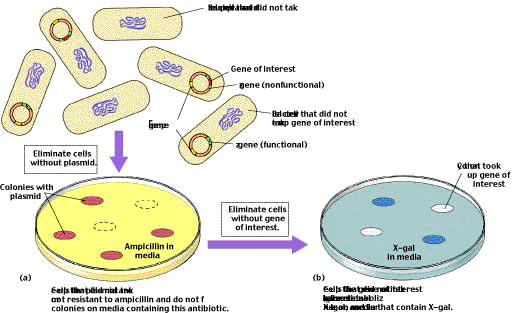Stage 4: Screening
The clones containing a specific DNA fragment of interest, often a fragment that includes a particular gene, are identified from the clone library. Let’s examine this stage in more detail, as it is generally the most challenging in any genetic engineering experiment.
4I: The Preliminary Screening of Clones.Investigators initially try to eliminate from the library any clones that do not contain vectors, as well as clones whose vectors do not contain fragments of the source DNA. The first category of clones can be eliminated by employing a vector with a gene that confers resistance to a specific antibiotic, such as tetracycline, penicillin, or ampicillin. In figure 6a, the gene ampr is incorporated into the plasmid and confers resistance to the antibiotic ampicillin. When the clones are exposed to a medium containing that antibiotic, only clones that contain the vector will be resistant to the antibiotic and able to grow. One way to eliminate clones with vectors that do not have an inserted DNA fragment is to use a vector that, in addition to containing antibiotic resistance genes, contains the lacZ´ gene which is required to produce b-galactosidase, an enzyme that enables the cells to metabolize the sugar, X-gal. Metabolism of X-gal results in the formation of a blue reaction product, so any cells whose vectors contain a functional version of this gene will turn blue in the presence of X-gal (figure 6b). However, if one uses a restriction endonuclease whose recognition sequence lies within the lacZ´ gene, the gene will be interrupted when recombinants are formed, and the cell will be unable to metabolize X-gal. Therefore, cells with vectors that contain a fragment of source DNA should remain colorless in the presence of X-gal.
Any cells that are able to grow in a medium containing the antibiotic but don’t turn blue in the medium with X-gal must have incorporated a vector with a fragment of source DNA. Identifying cells that have a specific fragment of the source DNA is the next step in screening clones.  Figure 6
Figure 6
Stage 4-I: Using antibiotic resistance and X-gal as preliminary screens of restriction fragment clones. Bacteria are transformed with recombinant plasmids that contain a gene (ampr) that confers resistance to the antibiotic ampicillin and a gene (lacZ´) that is required to produce b-galactosidase, the enzyme which enables the cells to metabolize the sugar X-gal. (a) Only those bacteria that have incorporated a plasmid will be resistant to ampicillin and will grow on a medium that contains the antibiotic. (b) Ampicillin-resistant bacteria will be able to metabolize X-gal if their plasmid does not contain a DNA fragment inserted in the lacZ´ gene; such bacteria will turn blue when grown on a medium containing X-gal. Bacteria with a plasmid that has a DNA fragment inserted within the lacZ´ gene will not be able to metabolize X-gal and, therefore, will remain colorless in the presence of X-gal.